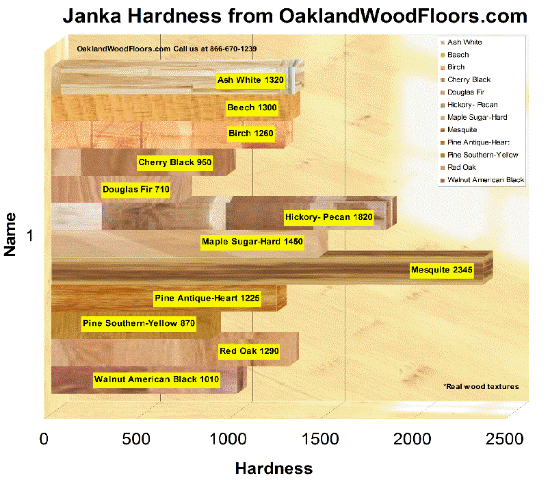 Janka
Hardness of Domestic wood species is the industry
standard for gauging the ability of various
wood species to tolerate denting and normal
wear, as well as being a good indication of
the effort required to either nail or saw
the particular wood.
Janka
Hardness of Domestic wood species is the industry
standard for gauging the ability of various
wood species to tolerate denting and normal
wear, as well as being a good indication of
the effort required to either nail or saw
the particular wood.{/tabs}
{slide=The Janka Hardness of Domestic Wood species measures} the force required to push a steel ball with a diameter of 11.28 millimeters (0.444 inches) inside the wood to a depth of half the ball's diameter (the diameter was chosen to produce a circle with an area of 100 square millimeters).{/slide}
{slide=In Janka's original test} the results were expressed in units of pressure, but when the ASTM standardized the test (tentative issue in 1922, standard first formally adopted in 1927), it called for results in units of force.The results for the janka hardness are stated in various ways in different countries, which can lead to confusion, especially when the name of the actual units employed is often not attached. In the United States, the measurement is in pounds-force(lbf) .{/slide}
{slide=The hardness of wood usually varies} with the direction of the grain remember that is usually 3 popular wood cuts . If the Janka Hardness test is done on the surface of a wood plank, with the force exerted perpendicular to the grain, the test is said to be of "side hardness." Side hardnesses of a block of wood measured in the direction of the tree's center (radially) and on a tangent to the tree's rings (tangentially) are typically very similar. End testing is also sometimes done (that is, testing the cut surface of a stump would be a test of end hardness). {/slide} The most common use of Janka hardness ratings is to determine whether a species is suitable for use as wood flooring or contruction frame.
Moisture Content is always a variant on any janka hardness test or table this mean that, side hardness increases with decreasing moisture content. In short in the Janka hardness The higher the number, the harder the wood. {tab=Domestic wood species}{/tabs}
{slide=Ash White or Scientific Name: Fraxinus americana } Properties: White ash is elastic and hard, and it has excellent shock-resistance. The wood remains smooth under friction. Janka Hardness: 1320 {/slide} {slide=Beech or Scientific Name: Fagus grandifolia} Properties: Beech is frequently used in factory floors and other high-traffic areas, since it wears well and stays smooth when subjected to repeated friction. The wood is hard and elastic, with excellent shock-resistance. Janka Hardness: 1300{/slide}
Birch or Scientific Name: Betula spp.
Properties: Birch is a very heavy, strong, durable wood. It is hard and stiff, with excellent shock-resistance. Janka Hardness: 1260
Cherry (Black) or Scientific Name: Prunus serotina
Properties: A strong but moderately hard wood with excellent shock resistance, black cherry is generally considered too soft for an entire floor; mainly it is found in borders and accents. Janka Hardness: 950
Douglas Fir or Scientific Name: Pseudotsuga menziesii
Properties: Douglas Fir has little natural resistance to termites or decay, and as such should be treated as a preventative measure. The wood remains smooth under friction and is reported to have no odor. Douglas Fir dries rapidly with little degrade resulting from the process. Janka Hardness: 710
Hickory-Pecan or Scientific Name: Carya spp. Properties: Prized for their resiliency, both hickory and pecan wood are exceedingly high in shock resistance, and they rank as the hardest of all North American hardwoods. Their combination of stiffness, toughness, hardness, and durability can be found in no other commercial wood, which is why they are used when an extremely hard and durable wood floor is desired. Janka Hardness: 1820
Maple Sugar-Hard or Scientific Name: Acer saccharum
Properties: Like black maple (B. nigrum), sugar maple is classified as a hardwood (other species of maple are considered soft). And like teak and white oak, it has a high crushing strength. It is stiff, strong, dense, and extremely tough, with excellent shock resistance. It is notably resistant to abrasive wear; and for this reason, it is the hardwood flooring of choice for such high-traffic/hard-use locations as bowling alleys, basketball courts, and other sports facilities. Janka Hardness: 1450
Mesquite or Scientific Name: Prosopis spp
Properties: In addition to its warm reddish tint, this moderately lustrous wood is notable for its hardness and durability Mesquite is extremely dense wood and very strong. Janka Hardness: 2345
Red Oak or Scientific Name: Quercus rubra Properties: White oak is slightly harder than red oak, and also more durable. However, both types are notably stiff and dense, have high shock resistance, and resist wear. Because of the high concentration of tannic acid in white oak, it is particularly resistant to fungi and insects. Janka Hardness: 1290
Pine Antique-Heart or Scientific Name: Carpinus betulus Properties: Pine species do not usually have a high resistance to decay, but they do have a propensity to absorb preservatives rather well. The wood commonly has no odor. Most pine species are not difficult or time consuming to dry properly. Janka Hardness: 1225
Pine Southern-Yellow or Scientific Name: Pinus taeda Properties: Pine species do not usually have a high resistance to decay, but they do have a propensity to absorb preservatives rather well. The wood commonly has no odor. Most pine species are not difficult or time consuming to dry properly. Janka Hardness: 870
Pine Antique-Heart or Scientific Name: Carpinus betulus Properties: Pine species do not usually have a high resistance to decay, but they do have a propensity to absorb preservatives rather well. The wood commonly has no odor. Most pine species are not difficult or time consuming to dry properly. Janka Hardness: 1225
Walnut American Black or Scientific Name: Juglans nigra Properties: This is one of the most prized of North American hardwoods. Although American black walnut is somewhat softer than northern red oak, the wood is heavy, hard, and stiff and has excellent dimensional stability. It is moderatly dense, but very strong, with good shock resistance. Walnut is one of the most durable of the domestic commercial woods, even under conditions favorable to decay. Janka Hardness: 1010

